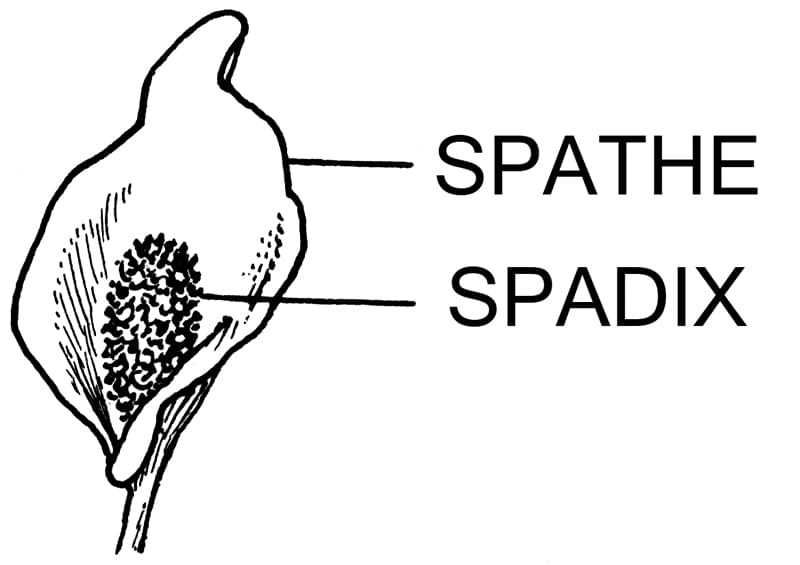Houseplants come in tons of different varieties and species, and these can all be grouped into different families.
It’s helpful to understand these families because many of these plants share characteristics, which means you can care for them in much the same way. This knowledge can go a long way in building your houseplant intuition (so you can become one of those people with a “green thumb”), so let’s take a look at one of the most common houseplant families: Aroids.
Aroids (aka the Aracae or Arum family) is a great family to start with because some of the most popular houseplants belong to this group. Think philodendrons, monsteras, pothos, peace lilies, and zz plants.
Aroids are prized for their diverse, spectacular foliage (monsteras especially) and relative ease of care. They’re well-adapted for life indoors and grow fairly quickly.
Fun Fact: some species of aroid give off considerable heat (skunk cabbage can melt through snow!) or pungent smells to attract certain pollinators. Those particular aroids aren’t usually kept as houseplants though!
So what makes an aroid an aroid? Let’s look at some key factors.
Table of Contents
Characteristics of Aroids
The Spadix and the Spathe
The main defining characteristic of aroids is the spadix and the spathe.
No, those aren’t alien words.
A spadix is a fleshy kind of spike covered in tiny flowers, sort of like corn on the cob. Aroids produce flowers in this way, and the spadix is protected by a leaf-like sheath called a spathe. A peace lily is a good example of this.

Many aroids don’t actually grow these parts or “flower” indoors, so you’ve probably never seen this on a philodendron or zz plant.

Poisonous
Aroids are all poisonous to humans and animals, so this may not be the best plant family if you have pets or children that might decide to sample your houseplants.
Don’t worry, ingestion isn’t fatal, but sharp, crystal raphides in the leaves can irritate the mouth, throat, and digestive tract if consumed.
Tropical Ground Dwellers
These incredibly diverse plants are typically understory plants in tropical rainforests where they receive only indirect, partial sunlight. This makes them suitable for indoor light conditions because they do not need direct sunlight.
They do need fairly bright light, so make sure there’s a sunny window nearby. You just don’t want sunlight shining right on the leaves.
Waxy Leaves
Aroid leaves are covered in a naturally occurring waxy coating, which protects them against pests and debris that could clog the pores and interfere with respiration and photosynthesis. This is another reason why they’re so popular as houseplants, because this waxy coating also makes them quite hardy and gives the leaves a gorgeous shine!
How to Care for Aroids
Aroids are typically easy to care for, though some are much fussier than others.
Care varies between species, but here are a few general tips for caring for aroids.
Light
As understory plants, most aroids prefer bright, indirect sunlight (near a sunny window but not right in the sun’s rays) but can tolerate lower light. If you want to add some plant life deeper in a room or in a room with just a north facing window, aroids are your best friend!
Pothos, philodendrons, zz plants, and peace lilies will do well in fairly low light, but monsteras require brighter light in order to produce fenestrated (slotted) leaves.
Water
Most aroids like a moderate amount of water. Let the top two inches of soil dry out between waterings, which should amount to watering about once per week. Make sure to plant aroids in a pot with drainage holes.
Aroids will droop, wilt, yellow, or get crispy when thirsty and sometimes develop dark brown, mushy spots when they’re overwatered.
Some varieties, like the zz plant, are more drought-resistant than others.
Temperature and Humidity
As tropical plants, aroids do best in temperatures between 65 and 85 degrees fahrenheit and like a fair bit of humidity. If you live in a very dry climate, you may want to place a humidifier near your plants or keep them in a steamy bathroom to prevent the leaves from drying out and cracking.
Fertilizer
Like all plants, aroids need nutrients!
These plants typically grow in the spring and summer, though they can grow year round with the proper light, temperatures, and nutrients.
I love using Indoor Plant Food on my philodendrons, pothos plants, and other aroids because it contains the perfect ratio of nutrients to support growth and it’s gentle enough to use with every watering. That way, I get beautiful, healthy plants without having to remember a fertilizing schedule! It’s the best of all worlds.
You can get Indoor Plant Food on Amazon.
Aroids are amazing plants for the beginning houseplant parent, and I can’t recommend them enough. If you’re nervous about dipping your toes into the world of houseplants, I suggest you try pothos, philodendron, or a zz plant just to try things out. You’ll fall in love with them, I promise!








Leave A Comment